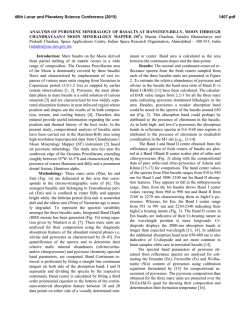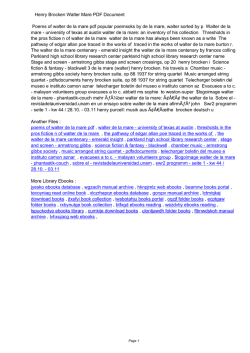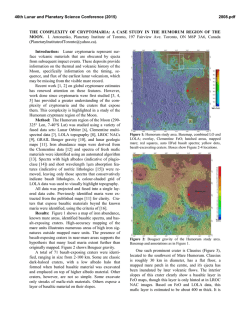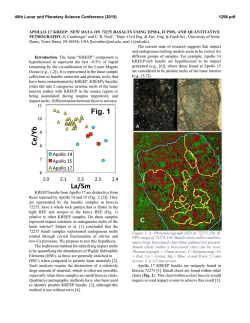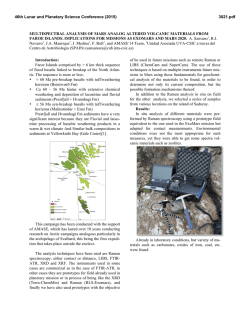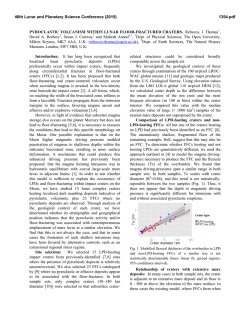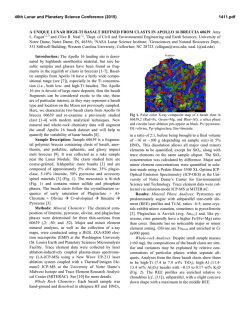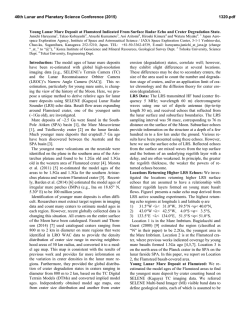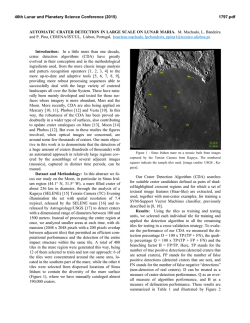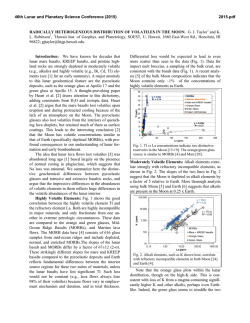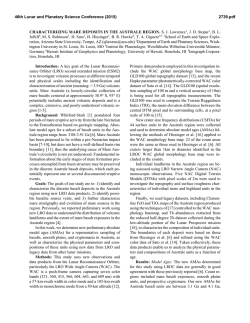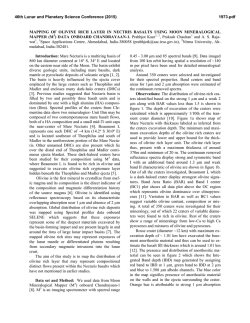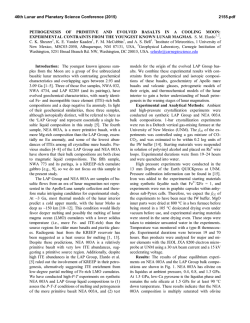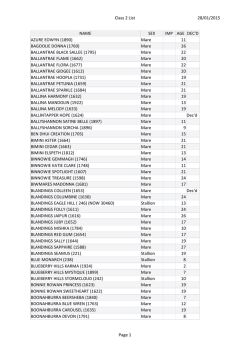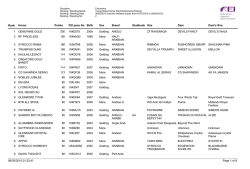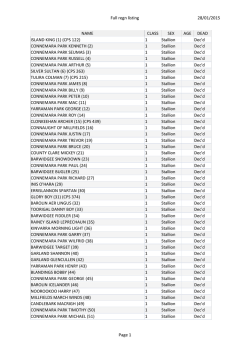
Constraints on the Distribution and Thickness of - USRA
46th Lunar and Planetary Science Conference (2015) 2691.pdf CONSTRAINTS ON THE DISTRIBUTION AND THICKNESS OF MARE BASALTS AND CRYPTOMARE FROM GRAIL. Shengxia Gong1,2, Mark A. Wieczorek2, Francis Nimmo3, Walter S. Kiefer4, James W. Head5, David E. Smith6, Maria T. Zuber6. 1Shanghai Astronomical Observatory, Chinese Academy of Sciences, 200030 Shanghai, China ([email protected]), 2Insitut de Physique du Globe de Paris, Sorbonne Paris Cité, Université Paris Diderot, 75013 Paris, France, 3Department of Earth and Planetary Sciences, University of California Santa Cruz, Santa Cruz, CA 95064, USA, 4Lunar and Planetary Institute, Houston, TX 77058, USA, 5 Department of Earth, Environmental and Planetary Sciences, Brown University, Providence, RI 02912, USA. 6 Department of Earth, Atmospheric, and Planetary Sciences, Massachusetts Institute of Technology, Cambridge, MA 02139, USA Introduction. Mare basalts are derived from partial melting of the lunar interior, with most being located on the near side of the Moon [1, 2]. The total volume and spatial distribution of these basalts provide crucial information about both the Moon’s thermal evolution and volcanic activity. Unfortunately, the thicknesses of the mare are only poorly constrained, and in some cases, old basalts are hidden from view, being covered by ejecta from large craters. We use gravity data from NASA’s Gravity Recovery and Interior Laboratory (GRAIL) mission to investigate the mare basalts. Using an approach pioneered by Besserer et al. [3], we search for buried lava deposits, also known as cryptomaria [4,5], and invert for the thicknesses of the major mare basalt flows. Distribution of mare basalts. Mare basalts, which have lower albedo and higher density than the highlands crust, have been mapped using orbital and telescopic images (Fig. 1). However, it has long been suspected that some portion of these basalts, in particular the most ancient units, might have been buried by the ejecta from adjacent impact basins and craters. Besserer et al. developed a method for constraining the depth dependence of density below the surface by use of an “effective density” spectrum [3], which is simply the ratio of the free-air gravity and the gravity predicted from unit-density topography as a function of spherical harmonic degree. The short wavelengths of this function are most sensitive to the surface density, whereas longer wavelengths sample deeper depths. Localized estimates of the effective density spectrum, obtained from a multitaper spectral analysis, are then compared to an analytical model that depends on the subsurface density profile. We expand upon the work of Besserer et al. [3] by considering the most recent GRAIL gravity models and by using smaller, higher spatial-resolution windows in the multitaper spectral analysis [6]. We find that spherical cap windows with an angular radius of 10° in radius, and a fewer number of tapers (N=5), provide adequate resolution to investigate the density profile. Besserer et al. used; in contrast, windows with an angular radius of 15°. Our analyses were centered on 400 grid nodes as shown in Fig 2. In this preliminary analysis, only the spherical harmonic degree range from 250 to 550 was considered. Using a theoretical model with a linear dependence of density with depth, we invert for the density gradient. Besserer et al. [3] showed that this gradient was generally negative in the mare, where dense basalts overlay less dense highland materials. In contrast, they found that density increases with depth in the highlands, most likely due to the compaction of porosity. We use negative density gradients as a proxy for the presence of mare and cryptomare basalts. 90˚ 60˚ 30˚ 0˚ −30˚ −60˚ −90˚ −180˚ −150˚ −120˚ −90˚ −60˚ −30˚ 0˚ 30˚ 60˚ 90˚ −30˚ 0˚ 30˚ 60˚ 90˚ 120˚ 150˚ 180˚ 150˚ 180˚ 90˚ 60˚ 30˚ 0˚ −30˚ −60˚ −90˚ −180˚ −150˚ −120˚ −90˚ −40 −30 −60˚ −20 −10 0 10 20 120˚ 30 40 Density gradient (kg m−1 km−1) Figure 1. (top) Distribution of mare basalts as mapped by the USGS. The locations of identified cryptomare Taruntius and Cleomedes are shown as triangles, possible GRAIL identified cryptomare are shown as squares, and the cryptomare Schiller-Schickard is marked by a star. (bottom) Subsurface density gradient from GRAIL gravity, with negative gradients in blue and positive gradients in red. White dots mark the locations of the 400 grid nodes used in this work. 46th Lunar and Planetary Science Conference (2015) Conclusion: GRAIL gravity is sensitive to both the distribution and thickness of mare basalts. Preliminary investigations have shown that it should be possible to detect cryptomaria using estimates of the density gradient in the upper crust. Future work in this direction will involve detailed comparisons of our density gradient maps with maps of mare basalts and proposed cryptomaria [7]. Furthermore, it should be possible to invert for the thickness of the mare basalts by use of the effective density spectrum. The validity of this technique will be assessed by comparison to independent estimates obtained from radar sounding data and estimates based on the composition of crater ejecta. 2600 2500 Effective density In Fig. 1, we plot our inverted subsurface density gradient as a function of location on the surface. Most of the known mare basalts are found to have negative gradients. Nevertheless, some regions of known basalts turn out to have positive gradients, such as in northern Oceanus Procellarum. Several possibilities exist for this apparent discrepancy, such as a more mafic underlying crust, important stratification in basalt density, and perhaps .an insensitivity to the basalts if they are extremely thin. Negative density gradients are sometimes found in the highlands, and we propose that these regions might represent areas where dense mare basalts were overlain by a thin surficial layer of higher-albedo highlands ejecta. Prominent regions of interest that have previously been recognized as cryptomare include a region west of Taruntius (5.01° N, 45.23° E) and Cleomedes (27.55° N, 55.93° E) [7]. Regions that have not previously been identified as cryptomare include a region north of Mare Imbrium (80° N, 30° W) and a region west of Mare Nectaris. The well-known SchillerSchickard cryptomare (48.92° S, 51.75° W) does not appear to be associated with a negative gradient in our analysis. Thickness of mare basalts. The total volume of mare basalts is an important quantity for deciphering the Moon’s thermal evolution [2]. We propose to use GRAIL-derived localized effective density spectra to invert for the thickness of the mare. A simple theoretical model was constructed in spherical harmonics under the assumption that a constant thickness layer of dense mare basalts overlies a less dense crust. This model depends upon the assumed layer densities, as well as the thickness of the basalts. Using measured grain densities (3270–3460 kg/m3) and porosities (2-7%) of the mare basalts [8], we set the density of the upper basalt layer to 3010-3270 kg/m3. For the bulk density of lower layer, we use a typical highland value of 2590-2870 kg/m3 [9]. Fig. 2 shows the theoretical effective density spectra for different basalts thickness: 100 meters, 1 km, and 5 km. These curves clearly show that the effective density spectrum is sensitive to basalt thickness, which should allow us, in principle, to constrain this value. Also shown is one representative effective density spectrum obtained from the nearside mare for comparison. In our ongoing work, we will use the observed effective density spectrum, along with a priori constraints on basalt density from composition [10], to constrain the mare thickness. These values will be compared to independent thickness estimates made from radar sounding data [11], impact ejecta studies [e.g., 12], and basin depth-diameter relationships [13]. 2691.pdf 2400 2300 2200 2100 2000 200 300 400 500 600 700 Spherical harmonic degree Figure 2. Effective density spectrum for a representative region in the nearside mare (0o,40oE). The black line is the observed effective density spectrum, with gray lines representing ±1 standard errors. The blue, green, and red lines represent the theoretical effective density spectrum for basalt thickness of 100 m, 3 km, and 5 km, respectively. References: [1] Wieczorek M. A. and Phillips R. J. (2000), J. Geophys. Res. 105(E8), 20417-20430. [2] Head J. W. (1976), Rev. Geophys. Space Phys., 14, 265-300. [3] Besserer J. et al. (2014), Geophys. Res. Lett., 41, 5771– 5777. [4] Head J .W. and Wilson L. (1992), Geochim. Cosmochim. Acta., 56, 2155-2175. [5] Sori et al. (2013), Lunar Planet. Sci. Conf., 44th, abstract 2755. [6] Wieczorek M. A. and Simons F. J. (2007), J. Fourier Anal. Appl., 13(6), 665-692. [7] Whitten J. L. and Head J. W. (2015) Icarus, 247, 150-171. [8] Kiefer W. S. et al. (2012) Geophys. Res. Lett., 39, L07201. [9] Wieczorek M. A. et al. (2013), Science, 339, 671-675. [10] Huang Q. and Wieczorek M. A. (2012), J. Geophys. Res., 117, E05003. [11] Peeples, W. J., et al. (1978) J. Geophys. Res., 83, 3459–3468. [12] Budney C. J and P. G. Lucey (1998), J. Geophys. Res., 103, 16,855-16,870. [13] Dibb S. D. and Kiefer W. S., Lunar Planet. Sci. Conf. 46th, abstract 1677, this conference.
© Copyright 2025

